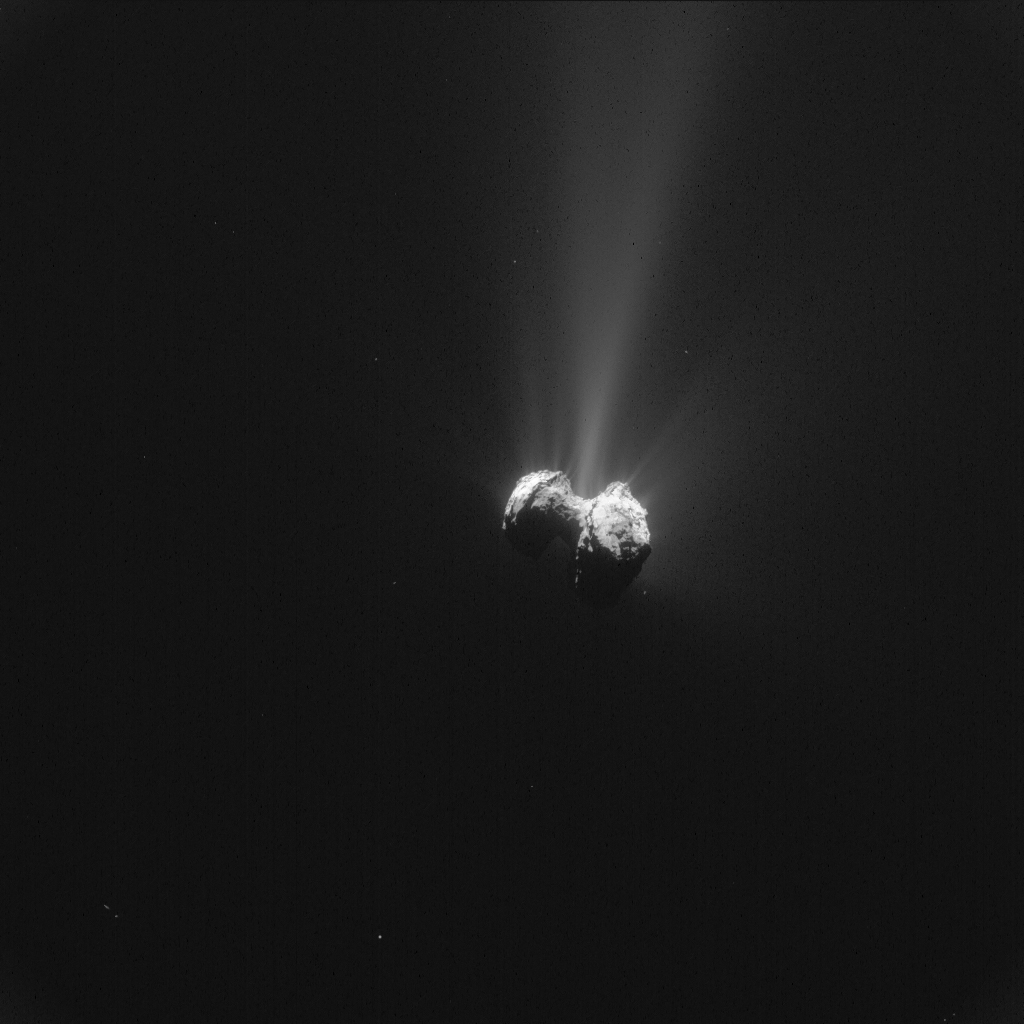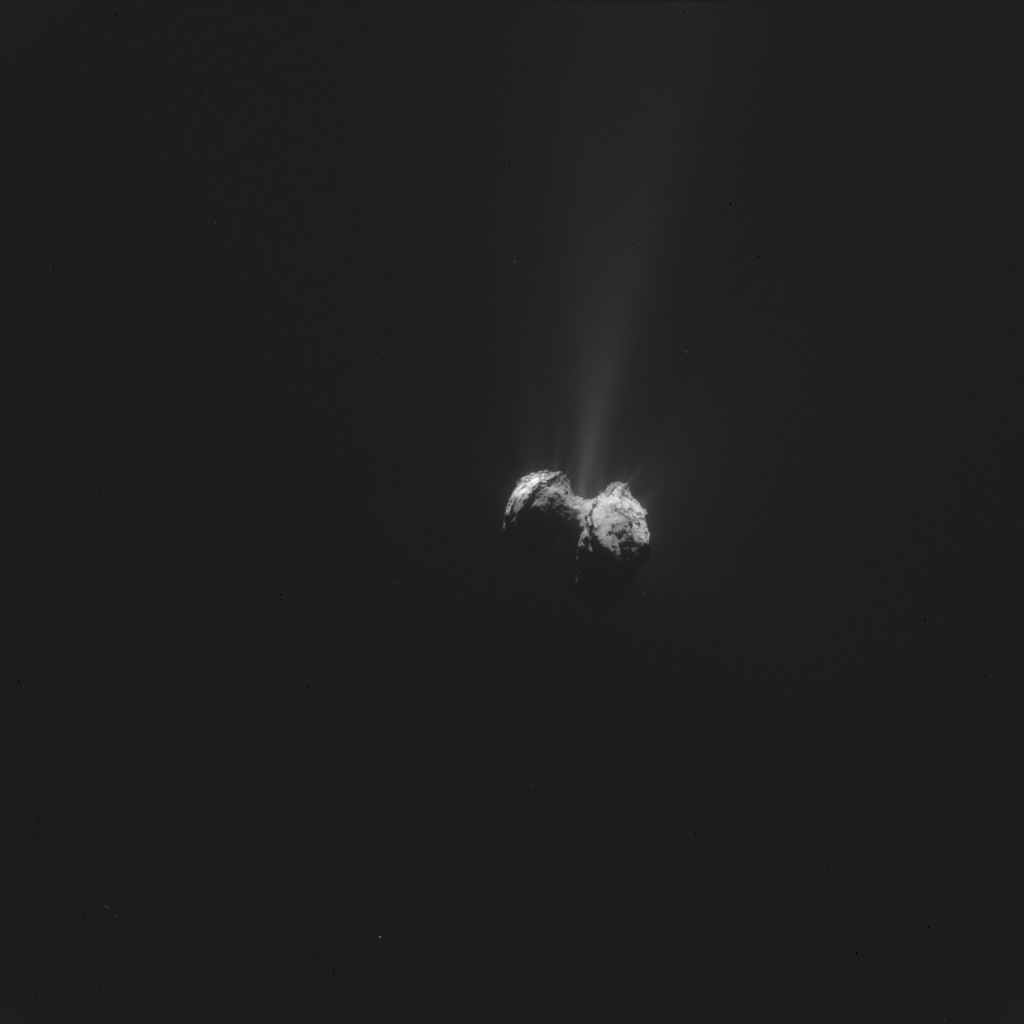Today’s CometWatch entry was taken by Rosetta’s NAVCAM on 21 September 2015, about 330 km from the nucleus of Comet 67P/Churyumov-Gerasimenko.

Single frame enhanced NAVCAM image of Comet 67P/C-G taken on 21 September 2015. Credits: ESA/Rosetta/NAVCAM – CC BY-SA IGO 3.0
The scale is 28.1 m/pixel and the image measures 28.8 km across. The contrast was increased to enhance the comet’s activity; the original image is provided below.
The comet is oriented with the small lobe to the left and the large lobe to the right. Jets of gas and dust are seen all around the sunlit portion of the nucleus and are particularly clear around the central neck region with the ejected material seen extending towards the edge of the image frame.
This week Rosetta embarked on a new trajectory that will take it 1500 km away from the comet nucleus by 30 September in order to study the broader scale of the coma and to investigate the comet’s plasma environment. It will return to closer distances in mid-October.
The original 1024 x 1024 pixel image from today’s entry is provided below:










Discussion: 34 comments
Seems most of the water is still going out from the neck. Does it look more carved? 🙂
If most of water at neck then this zone ‘geologically’ younger.
First image of formative scenario is that as the comet grows/accretes, statistically increases number, force, energy of impacts relative to its siblings. It becomes literally ‘hotter’ than environment. Being progressively ‘pushed’ by their small siblings to the border of the ‘nest’ [the big one being gently ‘pushed out’ by the myriad of small ones].
So, -at formative environment- super-volatiles at the core, volatiles at the middle, an quite dry at optical surface.
This is cometary fiction.
Update: if a binary met a third object. then mater in between the lobes could speculatively be sintered regolit, which adsorbed sublimates from them. South Plaque being result of some transient fusion, at bottom of third object’s regolit.
This is cometary fiction.
This scenario_ fits well with the ‘tabular pillar’ form of the neck 😉
Claudia’s pillar
https://blogs.esa.int/rosetta/2015/04/20/cometwatch-15-april-4-hours-later/#comment-436117
Coraline becoming ‘airborne’ at some later ‘shake it off’ 🙂
Also fits well with alignment of cubic crystallization on both lobes.
https://blogs.esa.int/rosetta/2015/08/13/rosettas-big-day-in-the-sun/#comment-504936
https://blogs.esa.int/rosetta/2015/08/13/rosettas-big-day-in-the-sun/#comment-512204
This is part of accretion line of argumentation.
Also fits well with vectorization of layers and ‘jets’ at neck.
On following this line, neck is going to be largely over-lived by the binary.
Revisiting library 63 at ESAC archives. Fits beautifully.
On impact on the third body, many body’s terraces inertia ‘folded’, a little aluminum like,
ROS_CAM1_20140816T230719
A very important experiment
So far Rosetta has been very close to 67P / Ch-G and it has been posible to learn about the INSIDE atmosphere of the comet.
The New measurements of the LARGE COMA Will give a moré detailed picture of the comet
How fast does the comet decrease in size?
Hi Andreas: It could show no great signs of decreasing, then, in a few days: boom!
https://blogs.esa.int/rosetta/2015/09/18/comet-surface-changes-before-rosettas-eyes/
THOMAS has quick sketched a mass loss of 45000 cubic meters.
Volume wise, looks like a crumbling down.
Looks like a Dinosaur now.
Please,
Find on my website an engraving dedicated to rosetta mission: The approach to the comet and final touchdown of Philae onto the comet.
Hope you’ll appreciate it.
Reguards,
Giovanni Slaviero
Insist, seems that there is “cooking”, beyond sunburn.
Remember_ those Dutch wooden shoes? Any soul who could be interested in this ‘Escher-esque’ variation of the binary model [‘the third object’], just go to library 63 and look for perspectives remembering those ones.
As Matteo says, stopping here, need to keep not too much attached to any model at this moment.
https://imagearchives.esac.esa.int/index.php?/category/63/
A remaining idea from some days ago, don’t want it to remain in limbo:
Neck_apex:
Hidden deep in the neck is the
parabolic line of the [low speed]
original impact on the regolith’s third body.
ROS_CAM1_20140904T142253
Most of material above it belong to the binary.
Famous ‘crack in the neck’ is at the apex
of this parabolic line. Suggesting that material above it
is a lot more fragile.
ROS_CAM1_20140905T140434
As for putting fractal-ism arguments also to rest for a while, Dr. Krauss article feels refreshing to me. An skeptic, by the way 🙂
https://nautil.us/issue/29/scaling/the-trouble-with-theories-of-everything
The parts I get to understand … 🙂
“…But Feynman was ultimately disappointed with what he had accomplished—something that is clear from his 1965 Nobel lecture…”
Capisce? Marco & Cooper?
“…The problem was not with the theory, but with trying to push the theory beyond the scales where it provides the correct description of nature.”. Extreme extrapolation…
This precision is from Dr. Krauss.
“While we don’t know the answers to that question, we should, at the very least, be skeptical.” 😉
Being skeptical is humbly accepting that what you know is related only to what you know.
[Closed Universes belong only to our minds].
This inherent limitation applies also to Systems Theory [and to computer science].
“…But if we expect our theories to be complete, that means that before we can have a theory of anything, we would first have to have a theory of everything”.
Seems Dr. Krauss has met the ‘mono’ bug.
“….It is a feature of our epistemology…”. Human epistemology would add. Proper of our interests, and limitations.
[That’s part of founded worries with AI. Once ‘ignited’ neural AI is ineluctably going to develop privative interests. But we need AI, an have to solve, or at least control this issue].
And as for closing this Feynman issue too:
“At least as likely is the possibility that nature, as Feynman once speculated, could be like an onion…”
There are ‘issues’ with onions on Science 😉